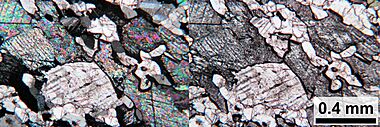Dolomite (mineral) facts for kids
Quick facts for kids Dolomite |
|
|---|---|

Dolomite (white) on talc
|
|
| General | |
| Category | Carbonate minerals |
| Formula (repeating unit) |
CaMg(CO3)2 |
| Strunz classification | 5.AB.10 |
| Crystal symmetry | R3 |
| Unit cell | a = 4.8012(1), c = 16.002 [Å]; Z = 3 |
| Identification | |
| Color | White, grey to pink, reddish-white, brownish-white; colourless in transmitted light |
| Crystal habit | Tabular crystals, often with curved faces, also columnar, stalactitic, granular, massive. |
| Crystal system | Trigonal |
| Twinning | Common as simple contact twins |
| Cleavage | 3 directions of cleavage not at right angles |
| Fracture | Conchoidal |
| Tenacity | Brittle |
| Mohs scale hardness | 3.5–4.0 |
| Luster | Vitreous to pearly |
| Streak | White |
| Specific gravity | 2.84–2.86 |
| Optical properties | Uniaxial (−) |
| Refractive index | nω = 1.679–1.681 nε = 1.500 |
| Birefringence | δ = 0.179–0.181 |
| Solubility | Poorly soluble in dilute HCl |
| Other characteristics | May fluoresce white to pink under UV; triboluminescent. Ksp values vary between 10−19 and 10−17 |

Dolomite is a cool mineral made of calcium and magnesium, mixed with carbonate. Its chemical formula is CaMg(CO3)2. The word "dolomite" is also used for a type of sedimentary rock that is mostly made of this mineral. Sometimes, people call the rock "dolostone".
Contents
Discovering Dolomite

The mineral dolomite was likely first described by a scientist named Carl Linnaeus in 1768. Later, in 1791, a French geologist named Déodat Gratet de Dolomieu studied the rock form of dolomite. He found it in old buildings in Rome and in the Tyrolean Alps.
A year later, in 1792, another scientist, Nicolas-Théodore de Saussure, officially named the mineral "dolomite" to honor Dolomieu. The famous Dolomites mountain range in Italy is also named after this mineral because it's made of dolomite rock!
What Dolomite Looks Like
Dolomite crystals usually form in a shape called trigonal-rhombohedral. They can be white, tan, gray, or even pink.
Special Features of Dolomite
- Double Carbonate: Dolomite is a "double carbonate." This means it has a special structure where calcium and magnesium atoms are arranged in an alternating pattern.
- Fizz Test: Unlike calcite, which fizzes quickly in cold, weak acid, dolomite doesn't fizz much unless it's ground into a fine powder. This helps scientists tell them apart.
- Crystal Twins: Sometimes, dolomite crystals grow together in a mirrored way, which scientists call "crystal twinning." This is quite common for dolomite.
Colors of Dolomite
Dolomite can have different colors depending on what other tiny bits of minerals are mixed in:
- If there's a little bit of iron in the crystal, it can look yellow or brown.
- If there's a small amount of manganese, the crystals can turn a lovely rosy pink.
- Other elements like lead, zinc, and cobalt can also be found in dolomite's structure.
How Dolomite Forms
Scientists are still learning exactly how dolomite forms, especially at cool temperatures. It's found in huge amounts in old rocks, but it's not very common to see it forming today.
Modern Formation
Today, dolomite has been found forming in special places like:
- Salty lagoons in Brazil, where there isn't much oxygen.
- Along coastal areas called sabkhas in the Persian Gulf.
- In places with gas hydrates and very salty lakes.
Some scientists think tiny living things like bacteria might help dolomite form. These bacteria can create sticky substances that help magnesium and calcium come together to make dolomite.
Ancient Deposits
Many ancient dolomite deposits formed when warm groundwater flowed through limestone rocks deep underground. This process is called dolomitization. It can also happen in places that weren't super hot, possibly with the help of tiny life forms deep within the Earth.
There's even a strange report of dolomite forming in the bladder of a Dalmatian dog, possibly due to an illness!
Uses of Dolomite
Dolomite is a very useful mineral and rock!
In Construction and Industry
- Building Material: It's used as a decorative stone and as a material in concrete.
- Magnesium Source: Dolomite is a source of magnesium oxide, which is used to make magnesium metal.
- Metal Production: It helps in the process of melting iron and steel (called smelting) by acting as a "flux."
- Glass Making: Large amounts of processed dolomite are used to make float glass, which is the flat glass used in windows.
In Nature and Farming
- Oil and Gas: Dolomite rock can hold petroleum (oil and gas) deep underground, making it an important reservoir rock.
- Metal Ores: It's often found where valuable base metals like lead, zinc, and copper are mined.
- Soil Helper: In gardening and farming, dolomite is added to soil to help balance its pH (how acidic or basic it is) and to provide magnesium for plants.
Other Cool Uses
- Aquariums: Dolomite is used in saltwater aquariums to help keep the water's pH stable for fish and other sea creatures.
- Clean Energy: It can act as a catalyst to help break down tar when turning plant material into gas at high temperatures.
- Particle Detectors: Scientists building particle detectors (machines that look for tiny particles from space) often place them under layers of dolomite. This is because dolomite has very low levels of natural radioactivity, which helps the detectors work better by blocking unwanted signals from cosmic rays.
For Collectors
Dolomite is also highly prized by mineral collectors and museums, especially when it forms large, clear crystals. Some of the best examples in the world come from a quarry in Eugui, Spain.
See also
- Dolomitization
- Evaporite
- List of minerals
- Magnesian Limestone
- Main Dolomite

